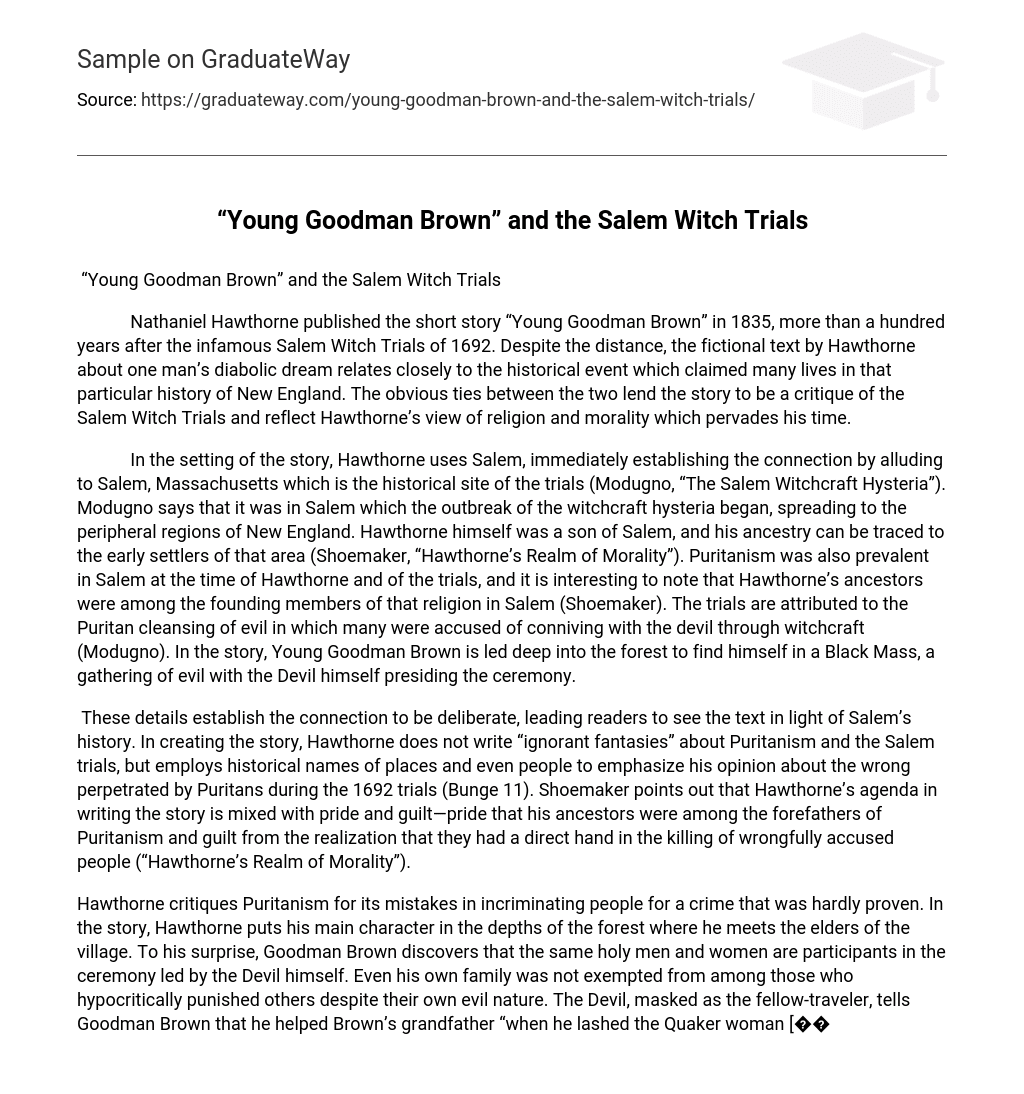Nathaniel Hawthorne published the short story “Young Goodman Brown” in 1835, more than a hundred years after the infamous Salem Witch Trials of 1692. Despite the distance, the fictional text by Hawthorne about one man’s diabolic dream relates closely to the historical event which claimed many lives in that particular history of New England. The obvious ties between the two lend the story to be a critique of the Salem Witch Trials and reflect Hawthorne’s view of religion and morality which pervades his time.
In the setting of the story, Hawthorne uses Salem, immediately establishing the connection by alluding to Salem, Massachusetts which is the historical site of the trials (Modugno, “The Salem Witchcraft Hysteria”). Modugno says that it was in Salem which the outbreak of the witchcraft hysteria began, spreading to the peripheral regions of New England. Hawthorne himself was a son of Salem, and his ancestry can be traced to the early settlers of that area (Shoemaker, “Hawthorne’s Realm of Morality”). Puritanism was also prevalent in Salem at the time of Hawthorne and of the trials, and it is interesting to note that Hawthorne’s ancestors were among the founding members of that religion in Salem (Shoemaker). The trials are attributed to the Puritan cleansing of evil in which many were accused of conniving with the devil through witchcraft (Modugno). In the story, Young Goodman Brown is led deep into the forest to find himself in a Black Mass, a gathering of evil with the Devil himself presiding the ceremony.
These details establish the connection to be deliberate, leading readers to see the text in light of Salem’s history. In creating the story, Hawthorne does not write “ignorant fantasies” about Puritanism and the Salem trials, but employs historical names of places and even people to emphasize his opinion about the wrong perpetrated by Puritans during the 1692 trials (Bunge 11). Shoemaker points out that Hawthorne’s agenda in writing the story is mixed with pride and guilt—pride that his ancestors were among the forefathers of Puritanism and guilt from the realization that they had a direct hand in the killing of wrongfully accused people (“Hawthorne’s Realm of Morality”).
Hawthorne critiques Puritanism for its mistakes in incriminating people for a crime that was hardly proven. In the story, Hawthorne puts his main character in the depths of the forest where he meets the elders of the village. To his surprise, Goodman Brown discovers that the same holy men and women are participants in the ceremony led by the Devil himself. Even his own family was not exempted from among those who hypocritically punished others despite their own evil nature. The Devil, masked as the fellow-traveler, tells Goodman Brown that he helped Brown’s grandfather “when he lashed the Quaker woman […] through the streets of Salem” (Hawthorne 597). Hawthorne overturns Puritanism and accuses its followers of the very judgment that imposes on others. He highlights the fact that Puritans believe man is inherently evil, yet they act as if they are holier than others.
Being a member of a Puritan family, it is not easy for Hawthorne to accept the fact of their family’s involvement in the Salem Trials. This is the source of Hawthorne’s guilt. It may be said that Goodman Brown parallels Hawthorne especially because Hawthorne’s ancestor, named John Hathorne, served as one of the witch judges in the trials (Modugno). As Goodman Brown is confounded and shaken in his own faith in God, Hawthorne doubts the integrity of his own religious beliefs. In writing the story, Hawthorne guards himself against the danger of turning into the hypocritical Puritans in both his fictional and real world.
Works Cited
Bunge, Nancy. Nathaniel Hawthorne: A Study of the Short Fiction. Michigan: Twayne
Publishers, 1993.
Modugno, Joseph R. “The Salem Witchcraft Hysteria of 1692 and ‘Young Goodman Brown’.”
Hawthorne in Salem. Northshore Community College. 17 February 2009
<http://www.hawthorneinsalem.org/Literature/Quakers&Witches/YoungGoodmanBrown/Introduction.html>.
Shoemaker, Jacqueline. “Hawthorne’s Realm of Morality:Biographical Contexts for ‘Young
Goodman Brown’.” American Literature Research and Analysis Web Site. 7 July 1997.
Florida Gulf Coast University. 17 February 2009 ;http://itech.fgcu.edu/faculty/wohlpart/alra/Hawthorne.htm#Text%202;.
;





